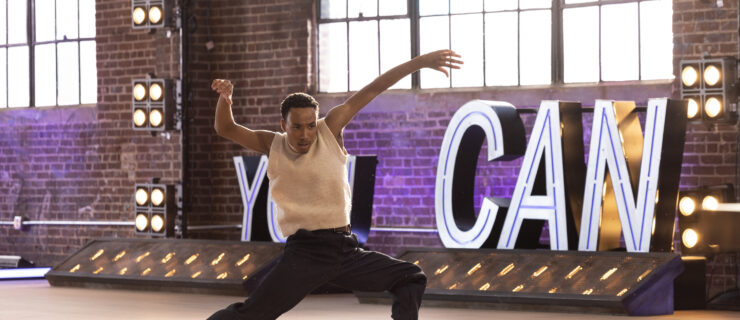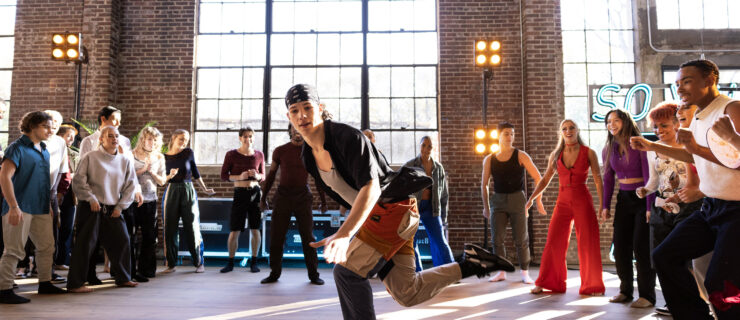Dancers with Degrees
While it may seem like four years spent training on campus means four fewer years of professional life, that’s not the case. Because as college graduates Allison DeBona, Peter Chu, Cat Cogliandro and Miguel Zarate will tell you, dancing in college doesn’t just give you extra technical training. It can also provide opportunities for self-discovery, networking and planning for the future. Here, they share why they chose college, and how it affected their careers.
With Ballet West’s Trevor Naumann in Val Caniparoli’s The Lottery (photo by Luke Isley, courtesy Ballet West)
Allison DeBona
First soloist with Ballet West; received a BS in ballet from Indiana University
College wasn’t really a choice in my family—everyone pushed me and my siblings to get a degree. Plus, I’d taken eighth grade through my sophomore year of high school off from ballet, so I didn’t think I was ready for a company contract.
I applied to Indiana University, Butler University, Mercyhurst University and New York University’s Tisch School of the Arts. Indiana was my first choice out of the ballet-heavy programs, and I got in. It was the perfect place for me. Julie Kent came to set a lot of our classical pieces; to have her coaching me in Swan Lake was mind-blowing. And Violette Verdy and Susan Pilarre taught us so many Balanchine ballets. What more could you ask for?
When I got into Ballet West, I felt very prepared. My days at Indiana were similar to my new schedule with the company—even the rep was similar. In college, I danced from 11 am until 5:45 pm every day, but I also had academic classes from 8 in the morning until late at night. It was almost harder to dance in college! I learned how to handle stress, which really pays off now that I’m dancing with Ballet West and juggling extra benefit performances, teaching appearances and even starting a summer program.
(Photo by Michelle Novak, courtesy Peter Chu)
Peter Chu
Director of chuthis.; received a BFA in dance from The Juilliard School
I graduated from a high school with top honors. At the time, I was really into cheerleading as well as dance, and I thought I might want to end up in sports medicine. I was set on going to Ohio State University, but at the last minute, I realized I wanted to dance, so I applied to Point Park University and got in with a scholarship.
A year later, I transferred to Juilliard, though I had to retake my freshman year. The first four semesters at Juilliard were very intimidating. I went through a lot of ups and downs—I felt like a child at the beach, riding the waves for the first time. I learned how to take initiative for my own career and work really hard.
I also made a lot of professional connections. (So far, I’ve only been to one cattle call audition in my life—and I’m very grateful for that.) I worked with a huge range of choreographers, from Ohad Naharin to Jacqulyn Buglisi. And when I graduated, I took a contract with another company I’d discovered while in school.
(Photo by Joseph Spelman, courtesy Cat Cogliandro)
Cat Cogliandro
Freelance choreographer; received a BFA in dance from SUNY Purchase
Growing up, I never considered not going to college. I graduated in the top 10 percent of my high school class. But I also knew I wanted to dance, so I auditioned for several conservatory programs, including the University of Arizona, Fordham University and, on a whim, SUNY Purchase. I was only accepted to Purchase.
The first two years of school were difficult for me. I was never chosen for any of the main-stage performances. I always felt overlooked. That said, not being cast in the school’s concerts did help me mature. I had more time to devote to my own choreographic process, and I learned how to deal with heartbreak and disappointment—a skill that comes in handy after graduation when jobs aren’t easy to get. Rejection is difficult to deal with. But I learned how to get let down, get back up and just say “OK, it’ll happen the next time,” or, “I’ll get the next one.”
My junior year, I got to work with Sidra Bell, and she reignited the fire in my gut. Her work showed me choreography could be something other than “Hit this movement on this note,” “Hit that on that note.” Her gestures were so intricate—she forced me to be more creative. I’d always known I wanted to be a choreographer and it was amazing to be in the studio with her.
(Photo by Rob Daly, courtesy Miguel Zarate)
Miguel Zarate
Choreographer and faculty member at The PULSE on Tour; received a BFA in dance from University of California, Irvine
I was very active in high school and took academics seriously. In my senior year, however, I asked my parents if I could move to L.A. to take part in EDGE Performing Arts Center’s scholarship program instead of going to college. My parents said absolutely not. So I looked for a school with a great dance department.
I applied to University of California, Los Angeles, and UC Irvine, and I got into both. UCI offered a better ballet program, and at the time I was a really technical dancer. I saw myself performing with a company like Alvin Ailey American Dance Theater or the Limón Dance Company.
That changed in college. One night I went to a house party, and when I heard a Kylie Minogue song and started freestyling, something clicked. In that moment, it felt like I’d discovered my voice. Soon after, I began experimenting with my own movement style in the dance department’s student choreography showcases, and I joined a dance team on campus, Kaba Modern. It introduced me to hip hop and breaking, and I felt encouraged to blend my technical background with funkier movements.
The technical training I received in UCI’s dance department sticks with me, and it’s a huge asset to my work as a jazz-funk choreographer. College also empowered me to be a better teacher. I’m able to connect with the whole class and articulate the movement. When students ask me about their next steps, I’m a big advocate for college. NYC and L.A. aren’t going anywhere. There’s no rush.



